
Hands On Review: Lifeline 64 OZ, Double Wall Stainless Growler – Two Temperature Tests
This is a review of the Lifeline’s 7500 64 oz, Double Wall Insulated Stainless Steel Growler.
Note: Since this review was published the design of this growler has changed. Search Lifeline Growler on Amazon for current designs and availability
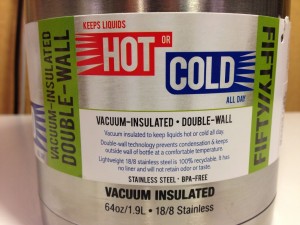
Front side of the label. It Reads: Vacuum-Insulated Double-Wall. Vacuum insulated to keep liquids hot or cold all day. Double-wall technology prevents condensation & keeps outside wall of bottle at a comfortable temperature. Lightweight 18/8 stainless steel is 100% recyclable It has no liner and will not retain odor or taste. Stainless Steel. BPA-free.
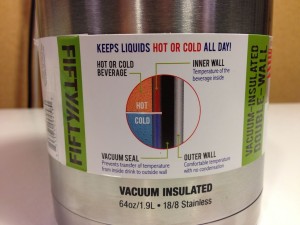
Reverse side of label (click for a larger view)
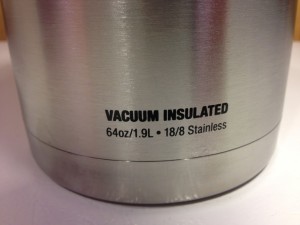
Reverse side – Vacuum Insulated – 64oz/1.9L – 18/8 Stainless
For size comparison – next to a standard growler
Temperature Test 1:
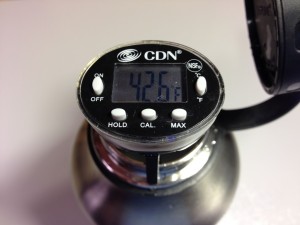
I filled this growler full of cold water. It ended up leveling out at 42.6 deg F.
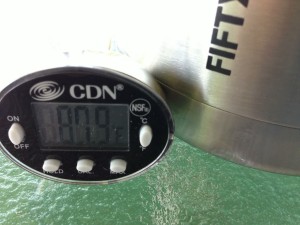
Next, I placed this outside. It was a warm day. My CDN DTQ450X read 87.9 deg F at 6:17 PM
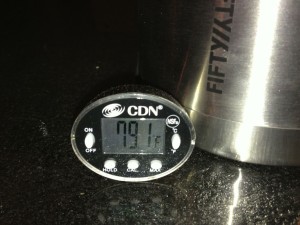
I brought the growler inside at 9:07 PM. At that time it was 79.1 deg F.
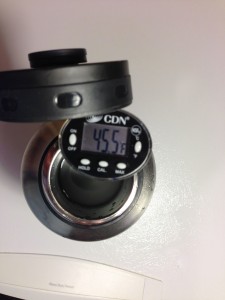
The contents were still at an amazing 45.5 degrees. That’s a loss of 2.9 degrees over nearly 3 hours of sitting in 87.9 – 79.1 deg F ambient temperatures. That ends up being an average of 1.02 degrees per hour. That’s crazy.
Temperature Test 2 – Side by Side Comparison with Standard Growler:
For this test I decided to ensure that each growler held the same mass of water. I did that by weighing both growlers and then subtracting the weight of the growler itself using the tare feature on my Escali Primo scale. Note that while the next two pictures were taken during that process, they do not show the weight of water that was used. I’m including them only so that you can compare the weight of a standard growler vs this stainless growler.
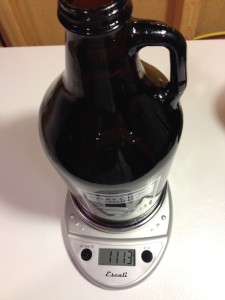
Weight of a standard growler 1,113 grams.
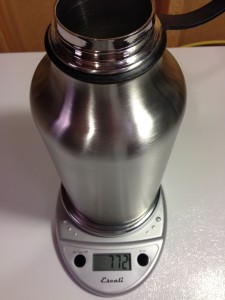
Weight of this stainless growler 772 grams. The stainless growler is 30% lighter.
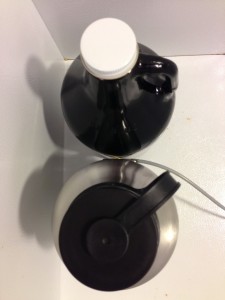
After getting the same amount of water in each growler I decided to chill these down in my fermentation deep freeze. Figuring that this would be a good way to get the contents close in temperature. I let these chill for a few days. They did get close in temperature but they were not identical. The standard growler came out at 37.5 deg F and the stainless growler came out at 39.2 deg F. Why the difference? I’m not sure, but I theorize it’s related to the insulation capabilities of the stainless growler.
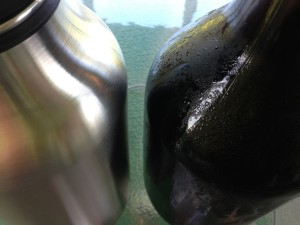
This is very early on in the test. Notice the condensation on the standard growler. Notice no condensation at all on the stainless growler.
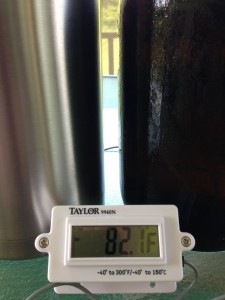
The starting ambient temp was 82.1 deg F. I picked up a Taylor 9940 Thermometer for this test because of it’s water proof probe and it’s long cable lead.
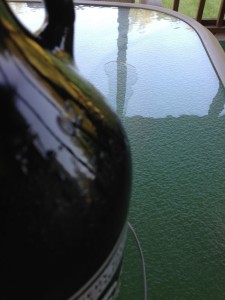
This picture was taken around first temperature check at 7:50 PM. If you look closely you’ll notice a puddle of condensation running down this table. The stainless growler continues to be bone dry.
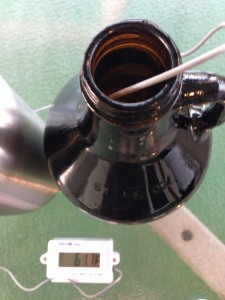
First temperature reading standard growler. 61.7 deg F.
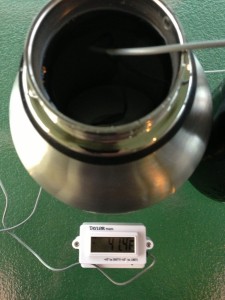
First temperature reading stainless growler. 41.4 deg F.
In the first period of the test, from 6:03 PM to 7:50 PM. The standard growler lost 24.2 degrees vs the stainless growler’s loss of a mere 2.2 degrees. That’s a difference of 22 degrees! 1.23 degrees per hour vs 13.57 degrees per hour. By the time you get to the last period, the standard growler is looking quite a bit better, but the fact is that it’s almost hit ambient temperature. In all over a span of 3.8 hours, the stainless growler lost mere 4.4 degrees.
I tried to perform these two tests in semi-extreme environments. Most of the time you won’t be just sitting a growler out in 80 or 90 degree weather. Performance in more realistic room temperature scenarios should be all the better.
Carbonation:
The question has arisen as to whether it is designed to hold carbonated beverages. I contacted the manufacturer and was told that yes indeed it is designed to work with carbonated beverages. I’ve also tested this myself. I chose to test with carbonated soda water, thinking that the high carbonation level would be a good test. I let the carbonated water sit in the growler for four days. It worked great.
This is a great growler. It looks amazing and the insulation performance blew me away. It also makes it into places that glass isn’t welcome like a pool or beach.
Note: Since this review was published the design of this growler has changed. Search Lifeline Growler on Amazon for current designs and availability
More Growler Reviews!
Convert Standard Growlers to Swing Top!
Growler Tips!
Growler Tips & Resources:
pinned
This post may contain affiliate links. We may make a commission when you use our links. This will never cost you extra. Thank you for supporting Homebrew Finds!
greatdealsreview:lifeline7500
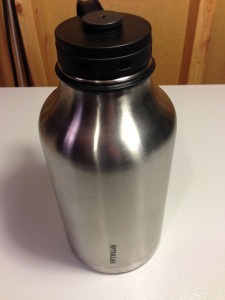
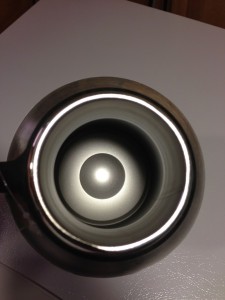
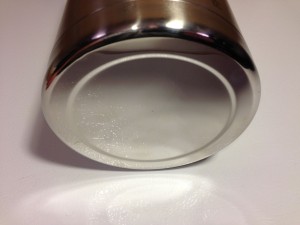
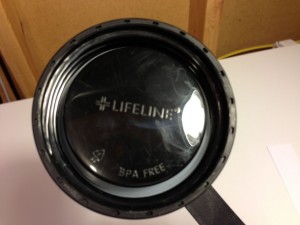
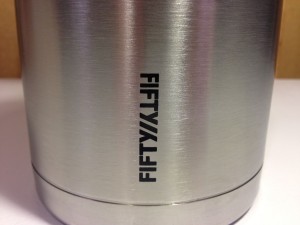
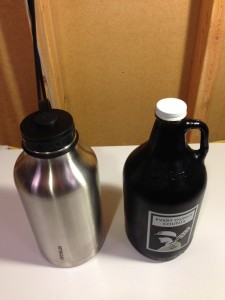
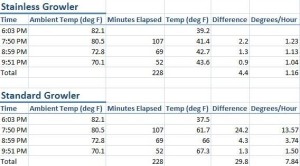
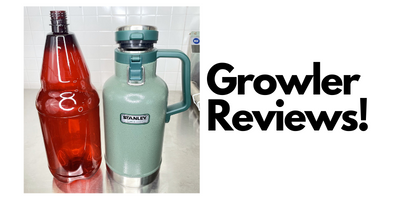
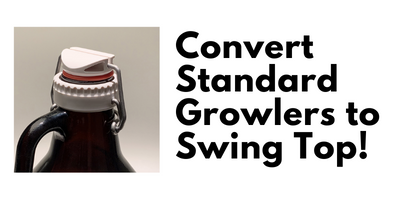
“The standard growler came out at 37.5 deg F and the stainless growler came out at 39.2 deg F. Why the difference? I’m not sure, but I theorize it’s related to the insulation capabilities of the stainless growler.”
^ I realize this is over a year old at this point and you may have found a reason, but I posed a couple questions about these growlers on Amazon before purchasing two. Somebody commented that filling these up with ice water to bring the temp down BEFORE filling from the tap is a good way to keep the beer colder. And as with any growler, chilling it may also keep the foaming down when filling.
I finally got around to using both of my growlers this past weekend and can vouch that these things are awesome! I chilled mine with ice water first, then poured from the tap (with the aid of a growler filler) Friday morning. There was a little foam, but nothing out of the ordinary. I cracked both open Friday evening to pour a glass; there was no perceptible drop in temperature or carbonation. Then over the course of a couple hours, both were kicked by late Saturday afternoon. Again, there was no perceptible loss in temperature or carbonation, even after sitting (covered) in the hot afternoon sun. Maybe the last half-a-glass was a tad warmer, but that’s to be expected.
I absolutely love these growlers and now I look forward to using them for a long time.
Frank- any difference b/t the lifeline and Hydro as far as performance? Thanks.
I own both a lifeline and Hydro – my pet peeve is they do not hold 64 OZ US standard it would appear they are measured by the imperial standard. more like 62 oz US or 1.8 liters not 1.9
Mine holds right at 64. For a slightly larger growler, check out the lifeline 7508. It holds 68+ ounces. https://www.homebrewfinds.com/hands-on-stainless-vacuum-sealed-double/
This is a great review. Thanks! I have the same growler in the powdercoated black and love is so far. I started getting curious about doing some experiments myself on how well it works, but now I don’t have to!
I’ve had mine filled twice now at two different places. Both times, the servers looked very confused when I handed it to them. I had to explain it was the same size. One of the servers did complain that they couldn’t see how much was actually in the growler and that it did foam up a lot more. Hopefully they will perfect the process of pouring into these containers, as I still like having the insulated container for long trips.
I’ve tried several stainless growlers and have always had issues with foaming. None of them are sufficiently polished on the inside surfaces, so they provide nucleation opportunities for the beer. The beer foams like crazy during the filling process, leaving a growler full of nearly-flat beer. What’s the interior surface of this one like? Mirror finish or just your standard unpolished stainless?
I bought a couple of the white-sided ones and they appear to have the unpolished stainless inside.
I can’t comment on the nucleation or foaming as I haven’t gotten them filled yet.
How long would you recommend storing beer in it?
Also, do you think you could put a picture next to a ruler or some standard size object to visualize how big this thing is?
I’d say the same as any other growler. This will probably store better than a standard growler because there is no light penetration and I would think the insulating effects of the growler would be good on the beer. Good idea on the picture. I’ve added a picture of this next to a standard size growler.
I know it would’ve been wasteful but why not test with beer? I mean this is what they were designed for and what we want to know about right?
I thought water was a close enough analog. If there is a difference my guess is that beer would have performed slightly better, because of the increased mass.